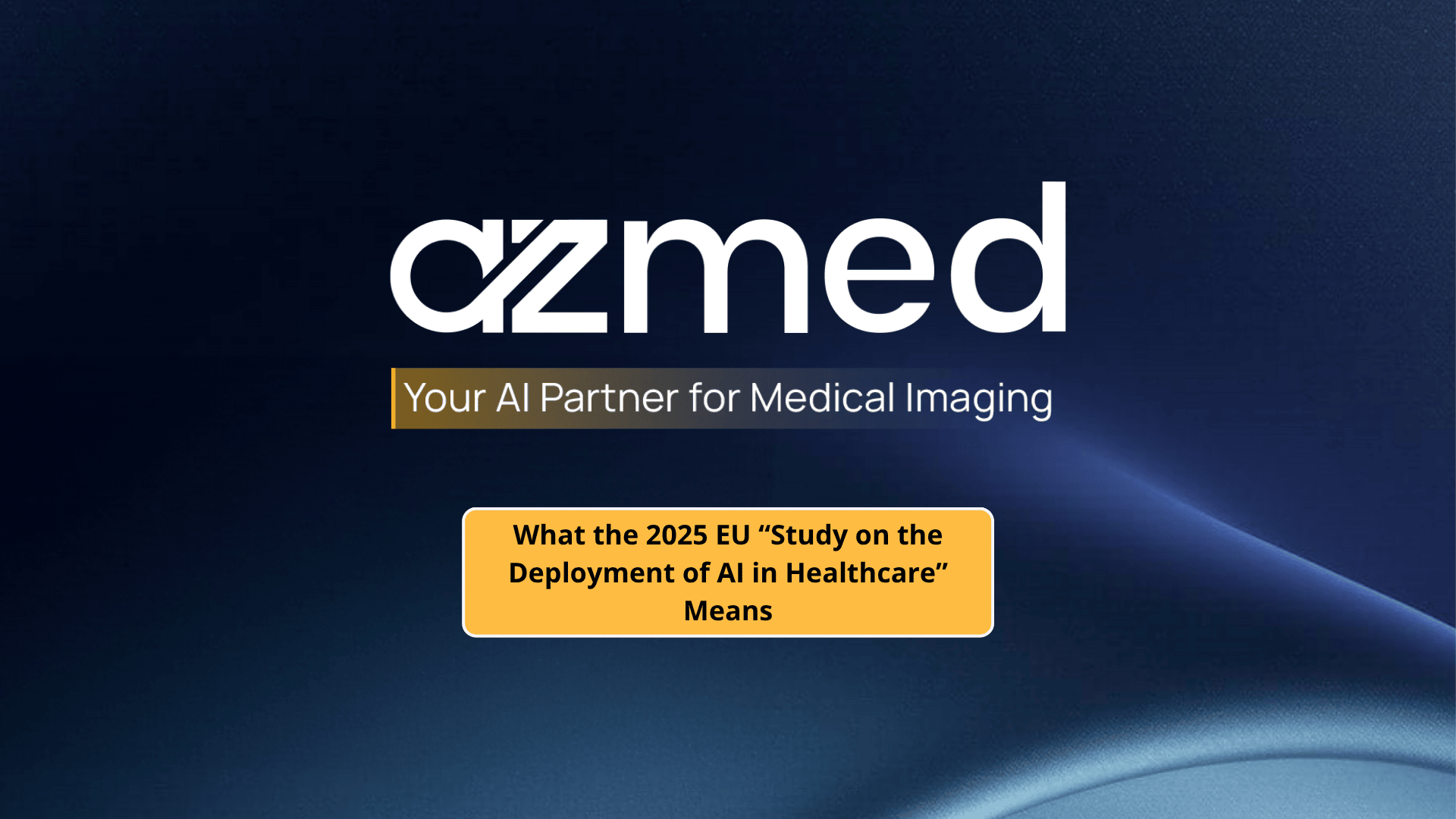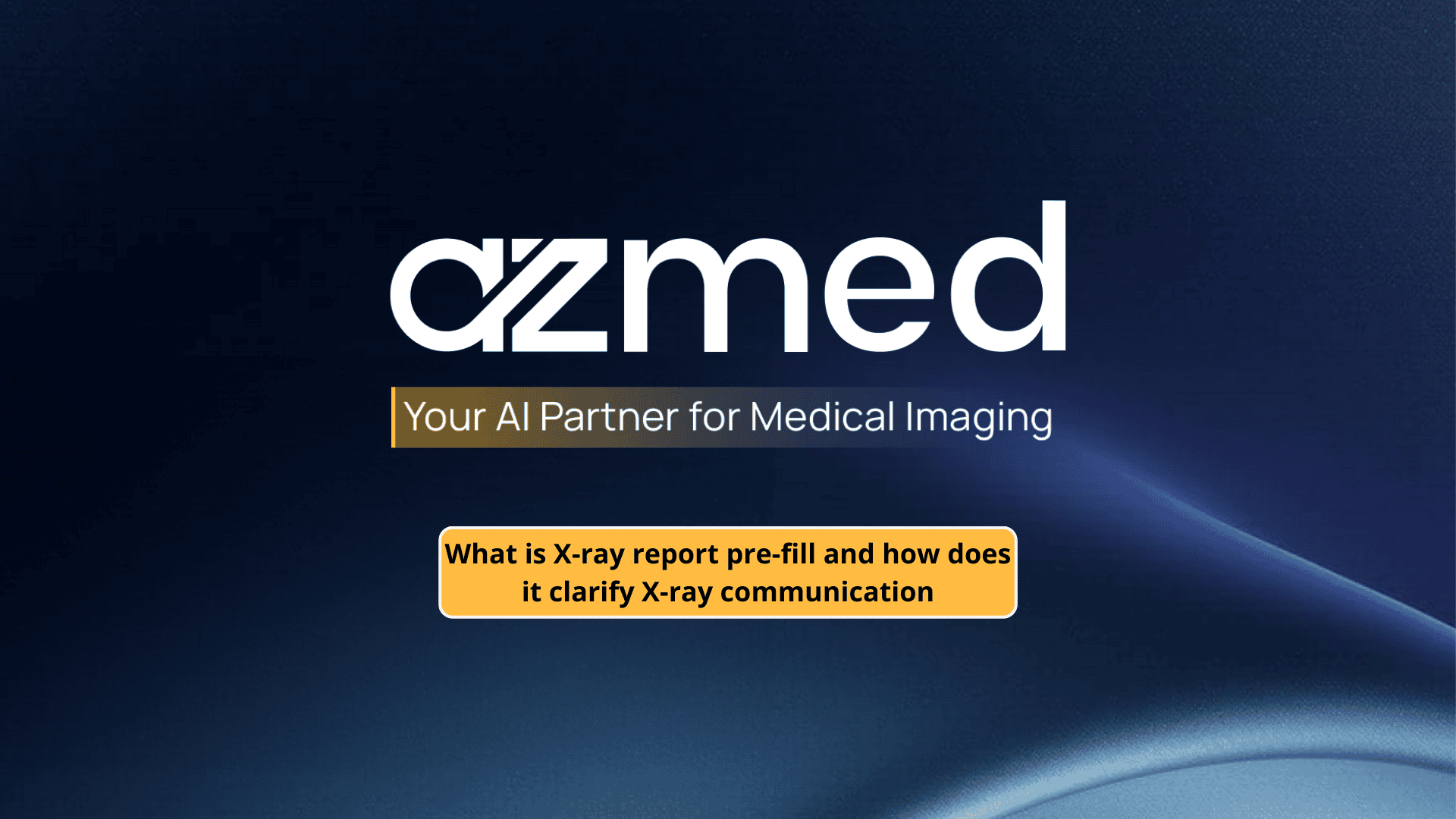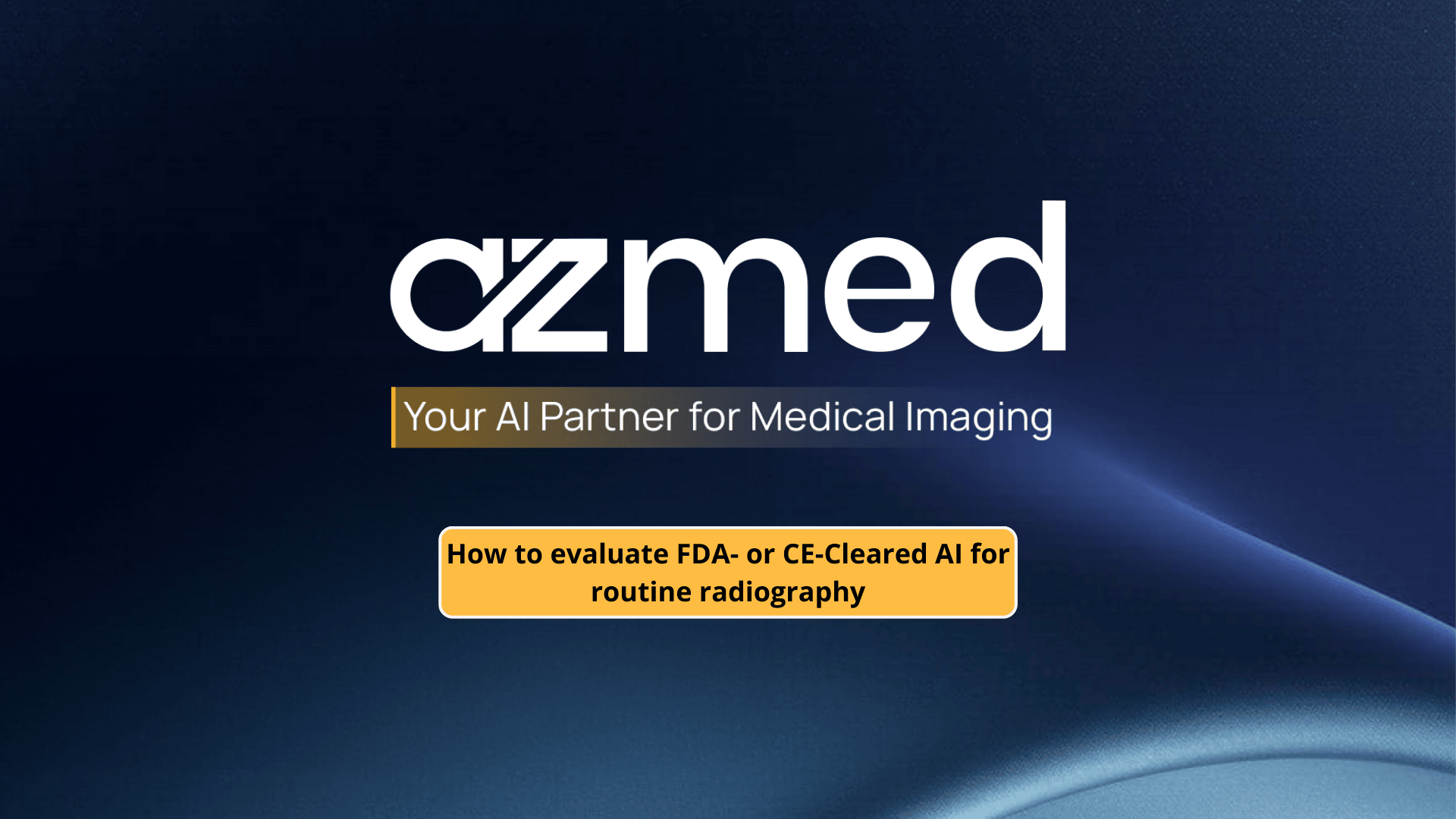A moment worth pausing for
In June 2025 the European Commission quietly completed a 227-page report whose abstract states:
“Artificial intelligence (AI) has the potential to address some of these by improving operational efficiency, reducing administrative burdens, and enhancing diagnosis and treatment pathways.” [1]
A single line, yet it distils why every hospital manager, radiologist and AI developer in Europe should read on. The authors go on to concede, with equal candour, that “despite the promise and availability of AI-based tools in the market, their deployment in clinical practice is slow.” [1]
For AZmed, one of the leading companies in AI Radiology born to accelerate diagnostic workflows, this new report is both validation and call-to-action. Below, we unpack its findings from this latest report, place them in today’s fast-shifting legal landscape, and translate them into concrete next steps that any imaging department can begin this quarter.
Why Europe is moving now
Europe’s hospitals are ageing along with their citizens. The share of people over 65 has already reached 21% and is forecast to approach 30% by 2050 [1]. Chronic diseases rise in tandem, while staff shortages deepen. Health-care professionals spend more than half of the time they devote to patient care working inside electronic health records rather than with patients [1].
AI, the study argues, is no longer optional. Even “low-hanging-fruit” applications—triage queues, smart worklists, ambient clinical scribes—can reclaim hours, cut burnout, and widen access to expertise beyond city hospitals [1]. Yet uptake crawls, hamstrung by fragmented rules, outdated servers and, above all, mistrust.
Those obstacles are precisely what Brussels has started to clear.
The policy trio that changes everything
1. The AI Act: a rulebook at last
“The new law aims to foster the development and uptake of safe and trustworthy AI systems across the EU’s single market by both private and public actors.” [2]
Adopted in May 2024, the AI Act classifies medical AI as “high-risk”. Far from a threat, this label finally hands developers a single compliance path instead of 27. The requirement for risk-management files and post-market monitoring mirrors good clinical practice AZmed already follows; the Act merely turns “nice-to-have” into a passport.
2. The European Health Data Space (EHDS): fuel for the algorithms
“The European Health Data Space (EHDS) regulation aims to improve individuals’ access to and control over their personal electronic health data, while also enabling certain data to be reused for research and innovation purposes for the benefit of European patients.” [3]
Approved in January 2025, the EHDS obliges Member States to adopt a common EHR exchange format. Once hospitals converge on the same Fast Healthcare Interoperability Resources (FHIR) pipeline, algorithm validation across borders becomes routine, not heroic.
3. The new Product Liability Directive (PLD): clarity on accountability
“The revision of that Directive would therefore encourage the roll-out and uptake of such new technologies, including AI, while ensuring that claimants enjoy the same level of protection irrespective of the technology involved and that all businesses benefit from more legal certainty and a level playing field.” [4]
Passed in October 2024, the PLD extends no-fault liability to software and AI updates. Hospitals can now sign purchase orders knowing exactly who pays if a model drifts. Developers, in turn, gain predictable insurance premiums.
Together, these three instruments deliver what the report calls Europe’s “unique position to support the safe, effective, ethical and equitable scale-up of AI deployment in healthcare” [1]
Decoding the report: four take-home insights for imaging teams
1. Workforce relief is real
A Johns Hopkins intervention cut emergency-room bed assignment time by 30% and OR transfer delays by 70% once AI was embedded in daily rounds [1]. Translate that to radiology: a prioritisation engine that flags suspected pneumothorax shaves minutes off every critical read, freeing scarce specialists for complex cases.
2. Administrative drain is fixable
Ambient scribes tested at Northwestern Medicine trimmed note-taking time by 24% and slashed “pyjama time” by 17% [1] . For AZmed customers, pairing voice capture with our fracture-detection pipeline could yield an end-to-end exam report before the next patient is even on the table.
3. Diagnostics grow faster under AI
Stakeholders rated AI-assisted diagnostics among the top three transformative use cases [1]. Yet the report cautions against “AI tourism”: algorithms that excel in training hospitals can drift elsewhere, especially where scanners differ. The lesson is local validation, a practice already embedded in AZmed’s CE-marked workflow.
4. Trust remains the make-or-break variable
Over half the patient organisations surveyed voiced doubts about AI decisions [1]. The authors therefore urge open metrics, standardised confidence intervals and plain-language explanations. Any vendor unwilling to surface that data will struggle once the AI Act’s transparency clauses bite.
Barriers still blocking the ward door
The study groups hurdles into four buckets—technological, legal, organisational and cultural [1]. Outdated servers, patchy broadband and siloed PACS remain real, especially in rural France or Eastern Europe. Interoperability demands FHIR conversions that many IT teams find daunting [1].
Money matters, too. Without DRG codes or dedicated AI budgets, radiology chiefs struggle to justify subscriptions—even when break-even models show clear ROI [1]. Finally, clinicians still fear being overshadowed or second-guessed by opaque machines.
The good news: every barrier comes with an accelerator. End-user co-design, assurance laboratories for post-market audits, and a Commission-backed catalogue of vetted tools all feature in the report’s roadmap [1].
What every hospital imaging team can do today
1. Start with radical transparency
Publish sensitivity, specificity and drift statistics on your website. Use layperson language when speaking to patients: Swedish radiologists found that standardised explanatory notes demystified AI and boosted acceptance [1].
2. Build an interoperable spine
Map your modalities to FHIR or OMOP once, not per-vendor. The upfront cost saves countless integration headaches later and positions the site for EHDS secondary-use funding streams.
3. Pilot small, then monitor forever
The Mayo Clinic’s “wheel of AI” shows that six-step pilots—define, design, engineer, assess, pilot, deploy—outperform big-bang rollouts [1]. Local assurance labs, soon encouraged by Brussels, will turn continuous monitoring into routine quality control rather than after-thought.
4. Quantify the clinical and financial delta
Boards sign cheques when shown numbers. Time-stamped worklists and PACS logs can capture minutes saved per case; group them into hours, then FTEs. Add avoided repeats and earlier discharges to present a simple margin story.
Five-year outlook: from point solutions to platforms
Table 9 in the Commission study sketches three scenarios. Even the “best case” foresees just 48% of European clinical workflows touched by AI by 2030 [1]. That may sound modest, yet remember that radiology reached near-universal PACS adoption in under a decade once standards aligned.
What flips the curve is not another fracture detector but a platform where multiple narrow models plug-in behind a single user interface. Think of AZmed’s Rayvolve® AI Suite serving as orchestra conductor, not soloist, harmonising triage, measurement, and report drafting in one place.
With the latest AI Act, EHDS and PLD now live, reimbursement codes and trust frameworks will follow. By 2028, hospitals that still treat AI as a pilot will find themselves competing for staff and patients against those who embedded it years earlier.
Conclusion: seize the momentum
Europe has handed the medical-imaging community three gifts: a common rulebook, a continent-wide data fabric, and clear liability lines. The 2025 Commission report offers the blueprint to use them.
The task ahead is simple, if not easy: validate locally, explain openly, monitor continuously. Do that, and the promise sketched in Brussels will become daily routine in radiology reading rooms from Paris to Pécs. The gong has sounded; now the real work begins.
References
- European Commission, Study on the Deployment of AI in Healthcare. Final Report, June 2025. https://op.europa.eu/en/publication-detail/-/publication/ew-01-25-076-en-n
- Council of the EU, Artificial intelligence (AI) act: Council gives final green light to the first worldwide rules on AI, press release, 21 May 2024. https://www.consilium.europa.eu/en/press/press-releases/2024/05/21/artificial-intelligence-ai-act-council-gives-final-green-light-to-the-first-worldwide-rules-on-ai/
- Council of the EU, European Health Data Space: Council adopts new regulation improving cross-border access to EU health data, press release, 21 January 2025. https://www.consilium.europa.eu/en/press/press-releases/2025/01/21/european-health-data-space-council-adopts-new-regulation-improving-cross-border-access-to-eu-health-data/
- Directive (EU) 2024/2853 of 23 October 2024 on liability for defective products, Official Journal L 2024/2853. https://eur-lex.europa.eu/eli/dir/2024/2853/oj



